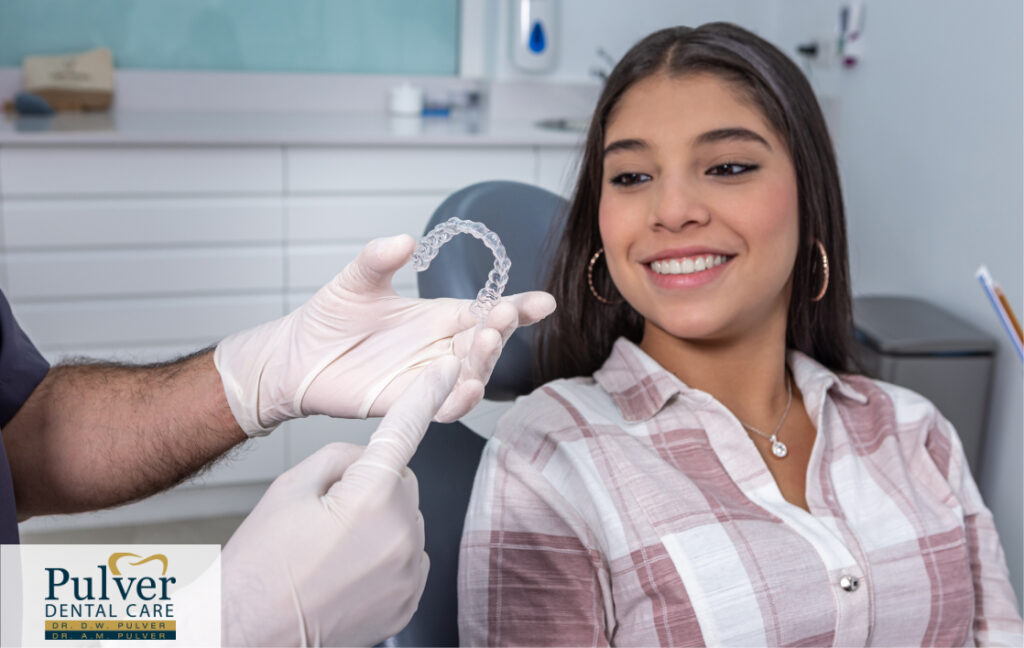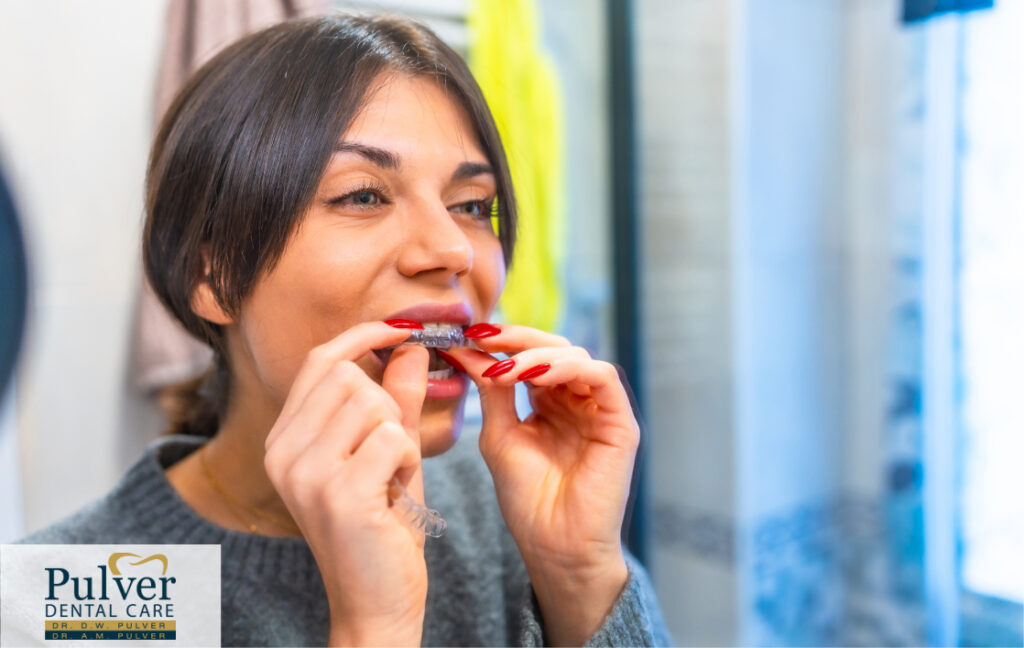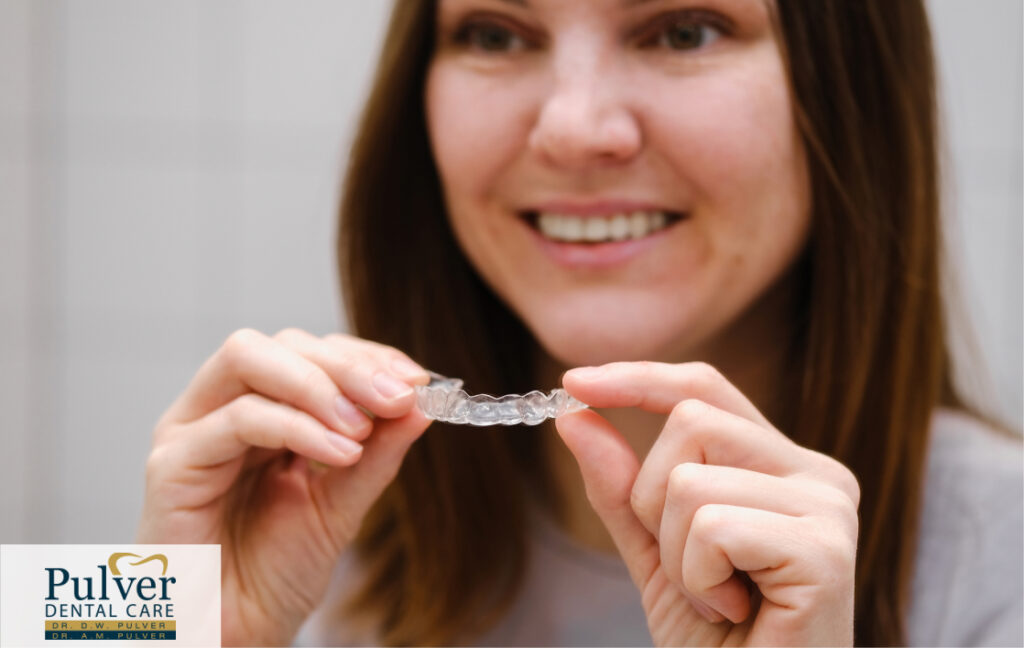Starting Invisalign® is an exciting step toward a straighter smile, but the first week can take some getting used to. Your teeth, gums, and even your daily habits will need time to adjust, but any initial discomfort is only temporary.
With a little patience and the right routine, you’ll quickly find that wearing your aligners becomes second nature—and before long, you’ll start seeing real progress in your smile.

Getting Used to Your Aligners
The first time you snap in your Invisalign® aligners, they’ll feel a little strange. Your teeth might feel tight, your tongue may not know what to do with them, and you could notice yourself swallowing more often than usual.
Don’t worry—this is all part of the adjustment period. Within a few days, your mouth will start to adapt, and wearing your aligners will feel much more natural.
A Gentle Squeeze on Your Teeth
It’s completely normal to feel some pressure when you first put in your aligners. After all, they’re designed to gently move your teeth into a new position. Some people describe it as a tight hug around their teeth, while others say it’s more like a dull ache. Either way, this sensation usually fades within a few days. If it feels uncomfortable, sipping cold water or taking an over-the-counter pain reliever can help.
The good news? That tightness means your Invisalign® is working.
Getting Comfortable Speaking
You might notice a slight lisp at first, and that can feel frustrating—especially if you have to talk a lot for work or school. This happens because your tongue needs to get used to having something new in your mouth.
The fastest way to adjust? Talk as much as possible.
Reading out loud or having conversations with friends will help your tongue figure things out more quickly. Most people find that within a few days, their speech sounds completely normal again.
Why Am I Swallowing So Much?
Your mouth reacts to your aligners the same way it would to a piece of food—it produces more saliva to help break it down. Since your aligners aren’t going anywhere, this extra saliva might make you feel like you need to swallow constantly at first.
The good news is that your body will adjust within a few days, and everything will go back to normal. In the meantime, staying hydrated and sipping water throughout the day can help keep things feeling comfortable.
The first few days with Invisalign might take some getting used to, but soon enough, you’ll hardly notice your aligners at all. Stick with it, and before you know it, wearing them will feel like second nature.

Managing Discomfort and Sensitivity
Starting Invisalign is exciting, but it’s normal to feel a little sore during the first few days. Your aligners are gently shifting your teeth into place, and your mouth is adjusting to the constant pressure. While this discomfort isn’t usually intense, it can make your teeth feel tender, especially when eating or removing your aligners. It doesn’t last long—in fact, most people find that the soreness fades within a few days as their mouth gets used to the aligners.
Simple Ways to Relieve Discomfort
If your teeth or gums feel sore, there are a few easy ways to make the transition more comfortable:
- Try an over-the-counter pain reliever. If the discomfort is noticeable, taking ibuprofen or acetaminophen can help take the edge off.
- Drink cold water. Sipping ice water can help reduce inflammation and provide a numbing effect for sore teeth.
- Use orthodontic wax. If your aligners feel rough against your tongue or gums, applying a small amount of Invisalign-approved wax can help prevent irritation.
- Stick to soft foods. Chewing can feel a bit uncomfortable at first, so eating softer foods like yogurt, mashed potatoes, smoothies, or pasta can make meals easier.
Discomfort Means It’s Working
While nobody loves feeling sore, it’s actually a sign that Invisalign is doing its job. The gentle pressure you feel is what moves your teeth into their new positions. If you don’t feel any tightness at all, it could mean your aligners aren’t fitting as snugly as they should.
So, as annoying as it might be, a little discomfort is a good thing—it means your smile is on its way to looking better than ever.
Within a few days, any soreness should fade, and wearing your aligners will feel much more natural. Hang in there—the adjustment period is temporary, and the results will be worth it!

Eating and Drinking Adjustments
One of the biggest changes with Invisalign is how you eat and drink. Unlike traditional braces, there are no food restrictions—but that doesn’t mean you can eat and drink as usual.
Since Invisalign aligners are removable, you’ll need to take them out before every meal or snack. While it might seem like a hassle at first, it quickly becomes part of your routine.
Always Remove Your Aligners Before Eating or Drinking
The only thing you can safely consume while wearing your aligners is plain water. Anything else—coffee, tea, soda, juice, or even a snack—can stain, warp, or trap bacteria inside your trays.
Even hot water can be a problem, as heat can slightly warp the plastic and affect how your aligners fit. To avoid any issues, make it a habit to take them out before eating or drinking anything other than water.
Brushing and Flossing Before Reinserting Aligners
Since aligners fit snugly over your teeth, any food particles left behind after eating can get trapped inside. This creates a breeding ground for bacteria, which can lead to cavities, bad breath, and stains.
After every meal or snack, it’s important to brush and floss before putting your aligners back in. If brushing isn’t an option, at the very least, rinse your mouth and aligners with water to help wash away food particles.
Foods and Drinks to Avoid
Even though you can eat whatever you want while your aligners are out, some foods and drinks can make life with Invisalign more challenging.
- Dark-colored beverages like coffee, tea, red wine, and soda can stain your teeth, which can become more noticeable with clear aligners.
- Sugary snacks and acidic drinks (like fruit juices and sports drinks) increase the risk of cavities if not properly cleaned off before reinserting aligners.
- Sticky or chewy foods (like caramel or gum) can make it harder to remove aligners if any residue sticks to your teeth.

Oral Hygiene and Aligner Care
Keeping your teeth and aligners clean is one of the most important parts of Invisalign treatment. Since the aligners sit snugly over your teeth, anything left behind—food particles, plaque, or bacteria—gets trapped against your enamel. Without proper care, this can lead to cavities, bad breath, and even discoloration of your aligners.
How to Keep Your Aligners Clean
Unlike traditional braces, Invisalign aligners are removable, which means they need regular cleaning. Each time you take them out, it helps to rinse them under lukewarm water to wash away saliva and bacteria.
For a deeper clean, Invisalign cleaning crystals or mild soap work well. Harsh cleaners like toothpaste should be avoided, as they can be too abrasive and create tiny scratches in the plastic. These scratches not only make aligners more noticeable but can also trap bacteria and cause odors. Soaking your aligners in a cleaning solution for a few minutes daily keeps them fresh and clear.
Maintaining a Strong Oral Hygiene Routine
Brushing and flossing become even more important with Invisalign. Since aligners hold everything against your teeth, any leftover food or plaque can quickly lead to decay. Brushing after every meal is essential before putting the aligners back in, and flossing at least once a day prevents buildup between teeth.
Using fluoride toothpaste strengthens enamel, while a non-alcoholic mouthwash can help keep your breath fresh throughout the day. If brushing isn’t an option, at the very least, rinsing your mouth with water can wash away some food debris before reinserting your aligners.
What Happens If You Skip Cleaning?
Neglecting oral hygiene with Invisalign can lead to noticeable problems. Aligners that aren’t cleaned regularly can develop a cloudy appearance, making them more visible when worn.
Over time, they may start to take on a yellowish tint, especially if they aren’t rinsed properly after drinking anything other than water.
Beyond appearance, dirty aligners can harbor bacteria, leading to bad breath and an increased risk of cavities. Skipping cleanings, even occasionally, can make aligners smell unpleasant and cause discomfort.
Adjusting to the 20-22 Hour Wear Rule
One of the most important aspects of Invisalign treatment is wearing your aligners consistently. Invisalign only works if it’s on your teeth for at least 20 to 22 hours a day.
The less you wear them, the longer your treatment could take—and in some cases, not wearing them enough can cause your teeth to shift incorrectly, making future aligners harder to fit.
Sticking to this wear time, and keeping track of it, ensures that your teeth keep moving in the right direction, keeping your progress on track.
Your First Week is Just the Beginning
The first week with Invisalign comes with a few adjustments, but once you get into a routine, everything starts to feel natural. Any initial discomfort, speech changes, or challenges with eating and cleaning will quickly become second nature.
Staying consistent with your wear time and keeping up with good oral hygiene will set you up for a smooth and successful treatment. Before you know it, you’ll start noticing changes in your smile—and each new aligner will bring you one step closer to your perfect teeth.

